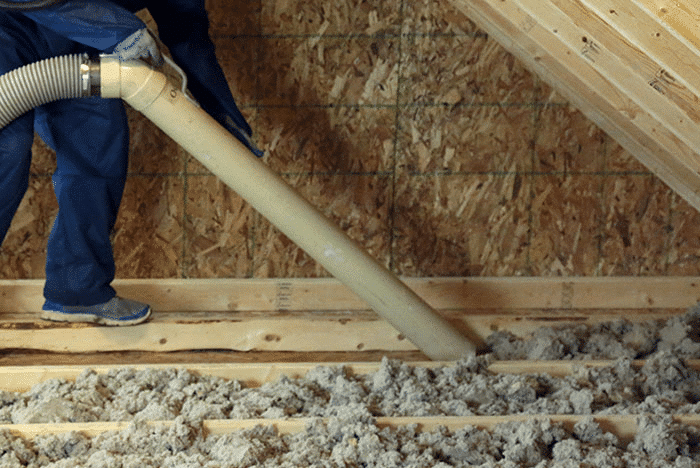Cellulose Insulation Problems: 5 Issues that Could Lead to Disaster


Traditional insulation like cellulose can be found in thousands of homes, but its popularity doesn’t mean it doesn’t have its problems.
Cellulose insulation is the oldest form of home insulation available on the market today. It can be installed as either a loose-fill or blown-in insulation. While it may be one of the oldest materials, cellulose can still have a number of issues ranging from dust getting all over your home to the material settling leaving areas uninsulated.
RetroFoam of Michigan has more than 17 years of experience insulating thousands of homes across the lower peninsula and greater Toledo area. While foam is all we do, we have insulated homes with cellulose insulation problems, so we know what to look for.
In an effort to educate homeowners, we have compiled a list of five cellulose insulation problems and how to fix them.
Cellulose Insulation Problems

From cellulose settling to the material leaving dust all over the home, here are some of the most common problems homeowners experience.
Cellulose Insulation Settles, Leaving Your Home Open to Air Movement
Modern cellulose settles up to 20 percent, according to House Energy.
Cellulose in walls can also sometimes separate over time, causing a gap – this is called bridging. When this happens, those gaps allow for air movement into and out of the home, which then leads to high monthly energy bills as your mechanicals work overtime to keep the house a constant temperature.
If there is loose-fill cellulose in the home, pests will move the material around to nest in creating a critter mess and large gaps in insulation coverage.
Solution: To ensure your home is covered the way you want it to be for insulation, it is important that you maintain the cellulose insulation in your home.
You may need to either rake the insulation to ensure it is even or install more to ensure you have the coverage that you need.
Cellulose Insulation Must be Kept Dry
Some cellulose insulation materials can absorb up to 130 percent water by weight.
Cellulose can get wet due to condensation, lack of air seal, or leaks in the home. The material dries very slowly after it absorbs the water, which causes it to deteriorate and settle. The water will also destroy the chemical fire treatment used in the material.
Solution: It is important to ensure that the cellulose insulation stays dry.
If the material becomes wet, your best option will be to replace it. Another option is to choose an insulation material that doesn’t retain water.
Dense Packed Cellulose Insulation Can Get Everywhere
Dense packed cellulose insulation can spill into the house through any openings in the wall cavity, like electrical sockets.
Homes with furnace duct systems can expect some of the cellulose dust to be recirculated throughout the house over time.
The same is true for loose-fill insulation. As it is blown or shifted around, the dust in the material kicks up and makes its way into the ducts in the home.
Solution: Great care should be taken when installing dense pack cellulose insulation, but honestly, the dust will still get everywhere.
The best option is to cover any openings and limit the amount of dust that will escape.
A project manager here at RetroFoam of Michigan spoke to a homeowner with cellulose in her attic, where her mechanicals were also located. She said once the cellulose was removed, she went from cleaning her home three times a week to just once a month.
Vents Can Cause Cellulose Insulation to Drift
If you use loose-fill cellulose insulation on the attic floor, the airflow from the vents will cause the material to drift, leaving spaces in the attic uninsulated.
Also, as that outside air moves through the cellulose, pollen, bacteria, and mold spores can cling to it. This becomes an issue when those particles are then circulated back through the home. If you suffer from allergies or asthma, this can cause a real problem.
Solution: Cellulose insulation should be monitored at a minimum of once a year to make sure it is level. You can rake the material to even it back out, but sometimes you may need to add more cellulose to get the coverage you need.
Cellulose Insulation is Very Difficult to Work With
Cellulose insulation is one of the most difficult materials to work with if you need new wiring or alterations to the home.
When a puncture is made in the cavity where the cellulose has been installed, the material just pours out of the hole. This leaves the cavity with large gaps in insulation coverage, and we already discussed what that leads to.
On the flip side, if you have glued-in cellulose in your walls, you won't be able to get it out without some major remodeling work.
Solution: One option would be to replace the insulation that spills out if you have loose-fill or tear out your walls if you have glued-in.
The other option is to choose an insulation material for your home that allows you to make updates as needed.
Worry-Free Insulation for Your Home
You have now gone through the problems associated with cellulose insulation, so you might be thinking you want to go with a different material.
If you would like more information on the benefits of foam insulation for your home, check out the Learning Center on our website.
Related Articles
How Much Does Cellulose Insulation Cost?
What is Cellulose Insulation? What's it Made of and How Does it Work?
About Amanda Ringler
Amanda previously has worked as a breaking news and crime reporter, TV news producer, and editor in Flint and Detroit. Throughout her career as a journalist, she has won several awards from The Society of Professional Journalists - Detroit Chapter and the Michigan Press Association. As part of the RetroFoam of Michigan family, Amanda uses her experience as a journalist to write content that will help educate homeowners on the benefits of foam insulation. When Amanda isn’t writing, she’s spending time with her husband and rescued huskies. She also loves knitting, making art, cooking, and hosting dinner and a movie night for friends and family.

.jpg)
